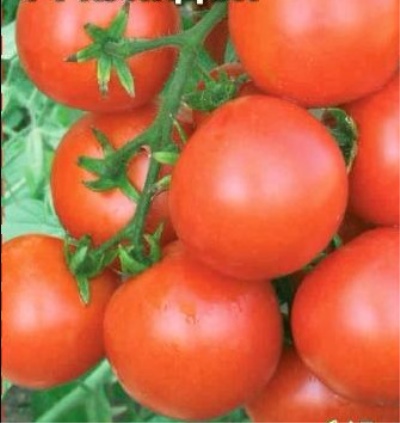
- Authors: Dubinin S.V., Kirillov M.I.
- Year of approval: 2004
- Category: hybrid
- Growth type: determinant
- Appointment: fresh consumption, for pickling and preserving
- Ripening period: early
- Ripening time, days: 90
- Growing conditions: for open ground
- Marketability: high
- Transportability: Yes
In the conditions of a short summer, the most optimal for growing in garden beds and in film greenhouses is an early-maturing or ultra-early variety of tomatoes. These include a hybrid tomato with the beautiful name Cupid.
Breeding history
The hybrid tomato Cupid was bred by a group of Russian breeders led by Dubinin and Kirillov in 2003. The variety joined the ranks of the breeding achievements of Russia and was entered into the State Register a year later - in 2004. The nightshade crop was zoned into all climatic zones of Russia. It can be grown both in greenhouses and in open ground.
Description of the variety
The Cupid plant is characterized by short stature and determinism. Compact bushes grow up to 60 cm. They have a weak thickening with small green leaves, a strong central stem, moderate branching, a developed root system and a simple inflorescence.
The first fruit cluster is formed above 5-6 leaves, where 3-6 ovaries (fruits) are formed. During cultivation, the formation and tying of bushes is not required, but you cannot do without removing unnecessary stepchildren, since air circulation must be ensured.
The main qualities of the fruit
The Cupid tomato belongs to large-fruited varieties. On average, a vegetable gains weight from 80 to 100 g. The tomato is characterized by a regular round shape without visible ribbing. Sometimes tomatoes are slightly flattened. In a state of full ripeness, the tomato acquires a bright red color, quite uniform. When unripe, the berry is light green without spots at the base. The peel of the berries is dense, smooth and shiny, which perfectly protects against cracking, and also ensures transportability and good keeping quality of the fruit.
Cupid tomatoes have a universal purpose, so they are eaten fresh, canned and processed for dressings. Tomatoes are ideal for whole-fruit canning.
Taste characteristics
The vegetable tastes sweet and sour, harmoniously complemented by a pronounced spicy aroma, which not all hybrid varieties have. The tomato pulp is fleshy, dense, juicy, without wateriness. There are few seeds in the pulp.
Ripening and fruiting
The culture belongs to the category of early tomato varieties. From the moment the first shoots appeared, only 3 months (90 days) pass until the tomatoes fully ripen on the brush. The berries ripen together.
Yield
This type of tomato is high-yielding. With proper agricultural technology, 6.6 kg of ripe berries can be harvested from 1 m2.
The timing of planting seedlings and planting in the ground
Sowing of seeds is carried out in March-April (depending on the climate and growing conditions). The seed is preliminarily disinfected and treated with a growth stimulator. For better germination, the senses in the box can be covered with plastic or glass. Diving (seating in separate containers) is carried out at the stage of the appearance of 2-3 leaves on the bush. Easy hardening of seedlings 10 days before transplanting to the garden will allow plants to quickly adapt to new growing conditions.
Disembarkation is carried out in May. Bushes should be strong, have 4-6 leaves. Plants are transplanted into heated soil when the average daily temperature reaches + 12-15 ° C.

Growing tomato seedlings is an extremely important process, because it largely depends on whether the gardener will be able to harvest at all. All aspects must be taken into account, from seedbed preparation to planting in the ground.
Landing scheme
When planting seedlings, it is imperative to observe the planting density, as well as plant the bushes according to a certain pattern, which will provide sufficient lighting and air movement. Planting density assumes the placement of 3-5 bushes per 1 m2. The scheme of 30x50 cm is considered acceptable for planting.

Growing and care
The variety is grown by the seedling method. Loose, breathable, fertile and moist soil is considered optimal for growth and fruiting. The best place will be an area where crops such as cabbage, radishes or carrots were previously grown.
Cupid needs comprehensive care, which consists of the following activities: watering with warm water, fertilizing, loosening the soil, removing stepchildren and extra leaves on the bushes, regular ventilation (if the plant is grown in a greenhouse), as well as the prevention of viruses and insect infestations.




A plant needs different micronutrients at each stage of growth. All fertilizers can be divided into two groups: mineral and organic. Folk remedies are often used: iodine, yeast, bird droppings, eggshells.
It is important to observe the rate and period of feeding. This also applies to folk remedies and organic fertilizers.
Disease and pest resistance
The culture has a high immunity, so it carries many tomato diseases (tobacco mosaic virus, fusarium wilting). Due to the early ripening period, tomatoes successfully bypass late blight.


Resistant to adverse weather conditions
The plant easily tolerates sudden temperature jumps. In addition, the nightshade culture is stress-resistant, does not respond to prolonged drought and heat.
Growing regions
A variety of tomatoes can grow in absolutely any climatic zone, not only in Russia, but also in Ukraine, Moldova.
Review overview
Tomato Cupid is massively grown both by summer residents and farmers, as it attracts with abundant and stable yields, excellent taste, and the ability to maintain its presentation for a long time.

























































































